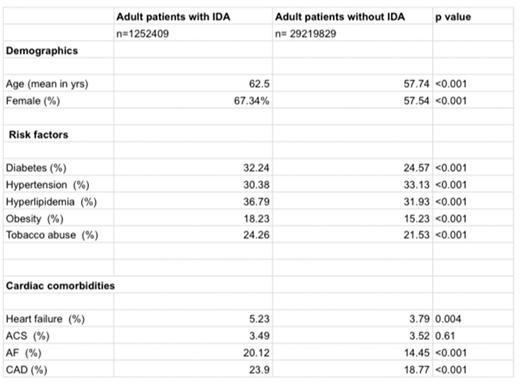Abstract
Introduction:
Anemia is a serious global public health problem. It causes a reduction in oxygen carrying and delivering capacity thereby counteracting the very function of the heart. There is some literature regarding iron deficiency and heart failure, however, less is known about the implications of iron deficiency anemia (IDA) in other cardiac conditions. We seek to find this association between IDA and cardiac conditions namely acute coronary syndrome (ACS), atrial fibrillation(AF), coronary artery disease (CAD), and heart failure (HF).
Methods:
The National Inpatient Sample 2017 was queried for the adult population (age>18 years) with a primary or secondary diagnosis of IDA. Prevalence of cardiovascular risk factors including diabetes mellitus (DM), hypertension (HTN), hyperlipidemia (HLD), tobacco use, and obesity were compared between patients with and without IDA. The association of cardiac diagnoses including ACS, AF, CAD, and HF with IDA was also analyzed.
Multivariate regression analysis was performed adjusting for chronic comorbidities taking all-cause mortality as a primary outcome and total cost of hospital stay as a secondary outcome. The association of the above cardiac conditions with these outcomes was studied.
Results:
A total of 1252409 (4.11%) adult patients were identified with a primary or secondary diagnosis of IDA in 2017. The mean age of this study population was 62.5 years and 62.34% of these were females.
In a cohort of adults with IDA being compared to adults without IDA ,DM (32.24 % vs 24.57%; p<0.001), HLD (36.79 % vs 31.93%; p<0.001), tobacco use (24.26% vs 21.53%; p<0.001) and obesity (18.23% vs 15.23%; p<0.001) were more prevalent. However, hypertension (30.38% vs 33.13%; p<0.001) was less prevalent in adults with IDA.
IDA was associated with greater prevalence of HF (5.23% vs 3.79%; p=0.004), CAD (23.9% vs. 18.77%; p<0.001) and AF (20.12% vs. 14.45%; p<0.001) but no such significant association was seen with ACS (3.49 vs 3.42; p=0.61)
Multivariate regression analysis after adjusting for demographics and risk factors showed increased mortality associated with AF (OR: 1.43; C.I :1.345- 1.534, p<0.001), ACS (OR: 2.40; C.I: 2.175- 2.658; p<0.001) and HF (OR: 1.163; C.I: 1.049-1.290; p=0.004) in the sub-population of adult patients with IDA.
Similarly, patients with IDA incurred significantly higher total costs when they had AF ( mean increase: $8910; CI: 7634- 10185, p<0.01) or ACS (mean increase: $38779; CI :35678- 41880; p=<0.01). However, the total cost was not statistically significant in patients with IDA and HF ($141; CI: -1707-2002; p=0.882).
Conclusion:
In our study, patients with IDA had a higher prevalence of CAD, AF, and HF. The odds of all-cause mortality in the subpopulation of IDA were higher if they had coexisting ACS, AF, or HF. The total cost of hospital stay was also higher in patients with IDA when they had ACS or AF, but no significant difference was noted if heart failure was coexisting with IDA. Although easily reversible, IDA given its high prevalence and potential to cause worse outcomes should be further studied in various cardiac conditions like ACS, CAD, and AF to better identify its role and develop therapeutic approaches which can limit mortality and morbidity.
Disclosures
No relevant conflicts of interest to declare.
Author notes
Asterisk with author names denotes non-ASH members.


This feature is available to Subscribers Only
Sign In or Create an Account Close Modal